High-energy particles rain down on Earth constantly, but scientists have now detected a doozy: a neutrino blasting in from deep space with an energy far greater than anything we’ve seen before.
On 13 February 2023, an undersea detector off the coast of Sicily picked up a record-breaking neutrino event. The particle’s energy was estimated to be a whopping 220 petaelectronvolts (PeV) – for reference, the previous record-holder is a paltry 10 PeV.
Only a handful of astronomical objects are capable of accelerating particles to such extreme energies, such as supernovae or black holes. One possible culprit could be a blazar – a particularly active supermassive black hole that’s firing a jet of radiation almost directly at Earth.
But given the unprecedented energy level, it could also be the very first cosmogenic neutrino ever detected, meaning it was born from cosmic rays interacting with photons from the background radiation left over from the Big Bang itself.
Neutrinos are elementary particles with no electric charge and a mass so tiny it was long thought to be zero. Billions of them are streaming through our bodies every second, but they interact so rarely with matter that we never notice.
The flip side is that this makes neutrinos very hard to detect. Doing so requires collecting a huge volume of a medium like water or ice, and watching it with thousands of ‘eyes’ for telltale flashes of light resulting from a cascade of interactions set off by neutrinos.
The record-breaking neutrino was detected by one of two Cubic Kilometer Neutrino Telescope (KM3NeT) arrays, located 3,450 meters (11,320 feet) below the surface of the Mediterranean Sea. There, 378 modules, each containing 31 light-sensitive detectors, keep watch on the surrounding water for the elusive flash of a neutrino.
During the 2023 event, over 28,000 photons were detected as particles produced by the neutrino’s passage streaked across the whole detector volume. The spray of particles came through almost horizontally, meaning the neutrino responsible for them must have traveled through quite a lot of rock and water in Earth’s crust before it hit an atom within view of KM3NeT.
The light itself came from another elementary particle called a muon, which are produced during the cascading interactions. This muon was estimated to have an energy of around 120 PeV, which is astonishingly high for these particles. But that’s nothing compared to its progenitor particle.
So what could launch a neutrino at such an unprecedented level of energy? Since these particles don’t interact much with matter, they can travel long distances undisturbed, making it hard to determine exactly where they came from.

The team investigated four hypotheses within the region of sky that the neutrino had come from. The source was either something within our galaxy; something outside of it but still within the local Universe; a transient event like a gamma-ray burst; or something from a distant galaxy.
Nothing in that direction really fit the first three options, the team found. That left just extragalactic sources, and of those, active supermassive black holes should dominate. Given how incredibly energetic this neutrino was, it would have to be a very active source, like a blazar.
Next, the researchers searched that region of sky in multiple wavelengths to identify blazars that could be responsible. A lineup of 12 was identified, but the case is far from closed.
“Given the large number of blazars in the sky, none of these associations can be considered compelling so far, and further investigations will be needed,” the authors write in a study about the event.
Another possibility is what’s known as cosmogenic neutrino production. This means the high-energy particles are generated as the result of cosmic rays interacting with the cosmic microwave background – the radiation left over from the Big Bang – or background light between galaxies.
If so, this would mark the first known detection of a neutrino produced this way. Further study will be required to solve the mystery one way or another.
The research was published in the journal Nature.





